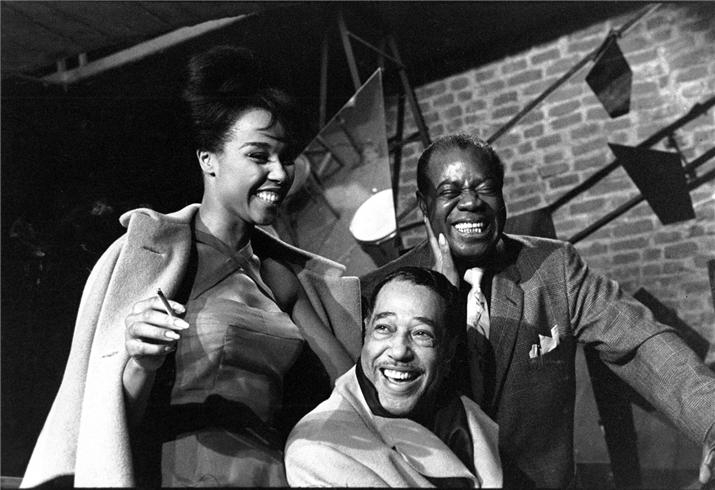The Great Summit

Louis Armstrong and Duke Ellington recorded only one album together, and it was a long time in coming. The Great Summit was made for Roulette Records in 1961, long after these two giants of jazz had come to prominence in the 1920’s, and several years after George Avakian proposed such a meeting for Columbia Records in 1955.
Avakian had been the producer of two concept albums by Armstrong in the mid-‘50’s, Louis Armstrong Plays W.C. Handy, and its successor, Satch Plays Fats. Both were critical and commercial successes, the former perhaps the finest studio session by Armstrong’s All-Stars, the name he gave the succession of small groups he worked with after disbanding his orchestra in 1947. Avakian also produced Armstrong’s classic recording of “Mack the Knife,” and he helped define the late-career Armstrong legend with an album of U.S. and European concert performances entitled Ambassador Satch.
Avakian’s ultimate wish for Armstrong was a showcase for the trumpeter with the orchestra of his one true peer, Duke Ellington. Both were receptive to the idea, but by the time it was proposed Armstrong’s Columbia contract had expired, and Armstrong’s manager Joe Glazer threw a wrench in the works when instead of agreeing to a contract extension, he insisted that Avakian put his proposal on paper. Glazer was a notoriously tough agent whose primary considerations were first and always financial. As Avakian told Armstrong biographer Terry Teachout in Pops: A Life of Louis Armstrong, “I didn’t trust Joe not to take my ideas to another label for more money than Columbia was offering…I decided that I didn’t want to go into it like that.” So Avakian abandoned the idea and continued his estimable work with Columbia artists Dave Brubeck, Miles Davis, and Ellington.
Over the next few years, Armstrong and Ellington crossed paths on a couple of occasions, including the Paul Newman-Sidney Poitier movie Paris Blues in which Armstrong’s character, Wild Man Moore, plays the Ellington numbers “Battle Royal” and “Wild Man” with studio ensembles. Closer to Avakian’s ideal, Louis was heard, albeit briefly, with the Ellington Orchestra on the Timex All-Star Jazz Show television special in 1959.
Otherwise, Armstrong had recorded surprisingly few Ellington tunes over the years; these included a superb treatment of “In My Solitude,” in 1935, and “Don’t Get Around Much Anymore” and “Do Nothin’ Till You Hear From Me” with Russ Garcia’s studio orchestra in 1957. “C Jam Blues,” which was re-born as “Duke’s Place” on the Roulette session, had been a feature for clarinetist Barney Bigard, the former Ellingtonian, during his years with the All-Stars.
Bob Thiele, who produced The Great Summit (and co-wrote the lyric for “Duke’s Place”), had been an A&R executive since the early ‘40s, working with a wide array of jazz and pop artists including Coleman Hawkins, Errol Garner, Buddy Holly, and Pat Boone. Soon after this date, he founded Impulse Records, the iconic jazz label synonymous with John Coltrane and a Thiele-fostered roster that ranged from Archie Shepp and Pharaoh Sanders to Johnny Hodges and Pee Wee Russell.
For The Great Summit, it was decided that Duke would sit in with the All-Stars on an exclusive program of Ellington material. He introduced two tunes at this date, an up-tempo blues entitled “The Beautiful American,” and “Azalea,” a ballad that Ellington had attempted to record twice before with other singers. Armstrong lent it the emotional reading it deserved, and why not? Ellington’s lyric was inspired by the way Armstrong wrote about the gardens of his native New Orleans in his first memoir, Swing That Music. Jazz historian Dan Morgenstern was present at the session and wrote about “how quickly and effectively each tune took shape for effective performance.” He credited Armstrong with being “one of the quickest studies to ever set foot in a studio.”
Armstrong digs into the rest of this set of Ellington standards with relish. In Louis Armstrong: An Extravagant Life, Lawrence Bergreen wrote, “He treated every syllable and note as if it contained essential truths.” Louis produces a magisterial two-chorus solo on “Black and Tan Fantasy,” and wrings deep feeling from “The Mooche,” “Mood Indigo,” and “I Got It Bad,” while “I’m Just a Lucky So and So” offers a unique example in Ellington’s vast discography of Duke accompanying a singer without additional ensemble backing. Anyone doubting Ellington’s genius as a pianist should pay attention to the penetrating touch, propulsive chords and imaginative backgrounds that are so prominent on this date.
The Great Summit is generally regarded as the last great album-length performance by Armstrong, whose chops were in continual decline throughout the 60’s. But his singing and soulfulness remained undimmed, and two more big hits lay ahead, “Hello Dolly” in 1964, and “What a Wonderful World” in 1968. The latter, co-written and produced by Thiele, may stand today as the best-known of Armstrong’s records. Ironically, as Ricky Riccardi relates in his recently published chronicle, What A Wonderful World: The Magic of Louis Armstrong’s Later Years, while the song was being recorded, a nasty dispute was being played out in the studio between Thiele and ABC-Paramount president Larry Newton who questioned its commercial viability.
Here it’s sung by Pops with Tyree Glenn on trombone
We’ll hear The Great Summit as our Golden Anniversary feature in tonight’s Jazz à la Mode.